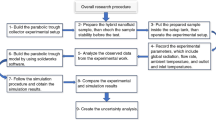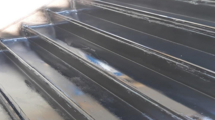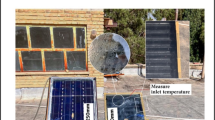Abstract
In this present research work, theoretical modeling of single slope, single basin solar still integrated with evacuated tubes has been performed based on energy balance equations. Major variables like water temperature, inner glass cover temperature and distillate output has been computed based on theoretical modeling. The experimental setup has been made from locally available materials and installed at Gujarat Power Engineering and Research Institute, Mehsana, Gujarat, India (23.5880°N, 72.3693°E) with 0.04 m depth during 6 months of time interval. From the series of experiments, it is found considerable increment in average distillate output of a solar still when integrated with evacuated tubes not only during daytime but also from night time. In all experimental cases, the correlation of coefficient (r) and root mean square percentage deviation of theoretical modeling and experimental study found good agreement with 0.97 < r < 0.98 and 10.22 < e < 38.4% respectively.










Similar content being viewed by others
Abbreviations
- \( \alpha^{\prime}_{g} \) :
-
Fraction of absorptivity of glass cover
- \( \alpha^{\prime}_{w} \) :
-
Fraction of absorptivity of water
- \( \alpha^{\prime}_{b} \) :
-
Fraction of absorptivity of basin
- (MC)w :
-
Heat stored by the water (kJ/kg)
- (ατ)eff :
-
Effective absorptivity transmissivity product
- AET :
-
Area of vacuum tubes (m2)
- AL :
-
Area of solar still (m2)
- As :
-
Area of solar still (m2)
- e:
-
Root mean square percentage deviation
- FR :
-
Friction factor (m2/s)
- h1 :
-
Total heat transfer coefficient (W/m2 °C)
- h2 :
-
Heat transfer coefficient from glass cover to ambient (W/m2 °C)
- h3 :
-
Heat transfer coefficient from basin to atmosphere (W/m2 °C)
- hc :
-
Convective heat transfer coefficient (W/m2 °C)
- he :
-
Evaporative heat transfer coefficient (W/m2 °C)
- h r :
-
Radiative heat transfer coefficient (W/m2 °C)
- hrw :
-
Radiative heat transfer coefficient (W/m2 °C)
- hw :
-
Enthalpy of water (W/m2)
- I(t)c :
-
Insolation on vacuum tubes (W/m2)
- I(t)s :
-
Insolation on solar still with coupling of vacuum tubes (W/m2)
- Kg :
-
Thermal conductivity of glass cover (W/m K)
- L:
-
Latent heat of vaporization (kJ/kg)
- Lg :
-
Thickness of glass cover (M)
- m:
-
Distillate output gained by passive solar still (kg)
- Mew :
-
Total distillate output gained by passive solar still at end of each day (kg)
- N:
-
Number of observations
- qb :
-
Rate of heat transfer from basin (W/m2)
- qcg :
-
Rate of energy lost from the glass cover by convective (W/m2)
- qcw :
-
Rate of energy lost from water by convection (W/m2)
- qew :
-
Rate of energy lost from water by evaporation (W/m2)
- qrg :
-
Rate of energy lost from glass cover by radiation (W/m2)
- Qu :
-
Heat gained by vacuum tubes when coupled with passive solar still (kJ)
- Rg :
-
Reflectivity of glass cover
- Rw :
-
Reflectivity of water
- t:
-
Time interval for the experient (3600 s) (s)
- Ta :
-
Ambient temperature (°C)
- Tb :
-
Temperature of basin (°C)
- Tci :
-
Tempertaure of inner side glass cover (°C)
- Tci0 :
-
Initial inner glass cover temperature before starting experiment (°C)
- Tco :
-
Outer glass cover temperature (°C)
- Tw :
-
Temperature of water inside passive solar still (°C)
- Tw0 :
-
Initial water temperature before starting the experiment (°C)
- Ub :
-
Heat transfer loss from basin (W/m2)
- UL :
-
Total heat transfer loss from passive solar still (W/m2)
- UT :
-
Total top loss from passive solar still (W/m2)
References
Rai SN, Tiwari GN (1983) Single Basin solar still coupled with flat plate collector. Energy Convers Manag 23:145–149
Panchal HN, Patel MI, Patel BT, Goswami RV, Doshi MI (2011) A comparative analysis of single slope solar still coupled with flat plate collector and passive solar still. Int J Res Rev Appl Sci 7(2):111–116
Titis C, Tiris M, Erdalli Y, Sohmen M (1998) Experimental studies on a solar still coupled with a flat-plate collector and a single basin still. Energy Convers Manag 30(8):853–856
Panchal HN, Shah PK (2012) Effect of varying glass cover thickness on performance of solar still: in a winter climate conditions. Int J Renew Energy Res 1(2):212–223
Badran OO, Al-Tahaineh HA (2005) The effect of coupling a flat-plate collector on the solar still productivity. Desalination 183(1):137–142
Kumar S, Tiwari GN (1996) Performance evaluation of an active solar distillation system. Energy 21(9):805–808
Panchal HN, Shah PK (2011) Modelling and verification of single slope solar still using ANSYS-CFX. Int J Energy Environ 2(6):985–998
Panchal HN, Shah PK (2012) Investigation on solar still having floating plates. Int J Energy Environ 3(3):1–5
Tiwari GN, Dhiman NK (1991) Performance study of a high temperture distillation system. Energy Convers Manag 32(3):283–291
Sodha MS, Kumar A, Tiwari GN (1981) Utilization of waste hot water for distillation. Desalination 37(3):325–342
Panchal HN (2016) Use of thermal energy storage materials for enhancement in distillate output of solar still: a review. Renew Sustain Energy Rev 61:86–96
Tiwari GN (2004) Solar energy: fundamentals, design, modeling and applications. Narosa Publishing House, New Delhi
Morrison GL, Budhihardjo I, Behinam M (2004) Water in glass evacuated tube solar water heaters. Sol Energy 76(1–3):135–140
Morrison GL, Budhihardjo I, Behinam M (2008) Water in glass evacuated tube solar water heaters. Sol Energy 83(1):49–56
Panchal HN, Shah PK (2014) Enhancement of distillate output of double basin solar still with vacuum tubes. Front Energy J 8(1):101–109
Panchal HN, Shah PK (2013) Performance analysis of double basin solar still with evacuated tubes. Appl Solar Energy 49(3):174–179
Karuppusamy S (2012) An experimental study on single basin solar still augmented with evacuated tubes. Therm Sci 16(2):573–581
Panchal HN, Shah PK (2016) Enhancement of upper basin distillate output by attachment of vacuum tubes with double-basin solar still. Desalin Water Treat 55(3):587–595
Panchal HN, Patel N, Thakkar H (2015) Various techniques for improvement in distillate output from active solar still: a review. Int J Ambient Energy. doi:10.1080/01430750.2015.1076518
Panchal HN (2016) Performance investigation on variations of glass cover thickness on solar still: experimental and theoretical analysis. Technol Econ Smart Grids Sustain Energy 1(7):1–11
Author information
Authors and Affiliations
Corresponding author
Appendix
Appendix
Following heat and mass transfer equations have used for the theoretical analysis of solar still integrated with evacuated tubes.
Total heat transfer coefficient is represented by:
The convective heat transfer coefficient is represented by:
The evaporative heat transfer coefficient is represented by:
The radiative heat transfer coefficient is represented by:
The main design parameters of the present solar still have been computed by following equations:
Overall heat transfer coefficient from glass cover to Ambient:
1.1 Error analysis
Thermocouples error analysis:
The accuracy of the thermocouple = ±1 °C
The minimum experimental value measured = 20 °C
Therefore the maximum possible error is 0.1/20 = 0. 05%
Error = 0.005 × 100 = 5%
Anemometer error analysis:
Accuracy of anemometer = ± 0.1 m/s
Minimum wind velocity measured = 1 m/s
Maximum possible error = 0.1/1 = 0.1%
Error = 10%
Solarimeter error analysis:
The accuracy of the meter = ± 1 W/m2
The minimum value measured = 40 W/m2
Maximum possible error = 1/40 = 0.025%
Error = 2.5%
Measuring jar error analysis:
Accuracy of collection tank = ± 10 mL
Minimum value measured = 100 mL
Maximum possible error = 10/100 = 0.01%
Error = 10%.
Rights and permissions
About this article
Cite this article
Panchal, H., Awasthi, A. Theoretical modeling and experimental analysis of solar still integrated with evacuated tubes. Heat Mass Transfer 53, 1943–1955 (2017). https://doi.org/10.1007/s00231-016-1953-8
Received:
Accepted:
Published:
Issue Date:
DOI: https://doi.org/10.1007/s00231-016-1953-8




